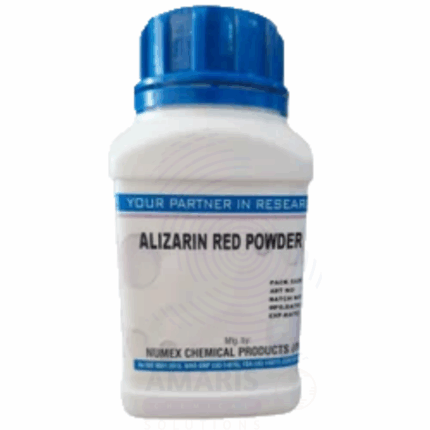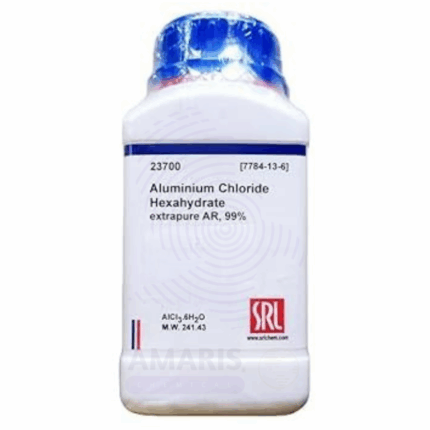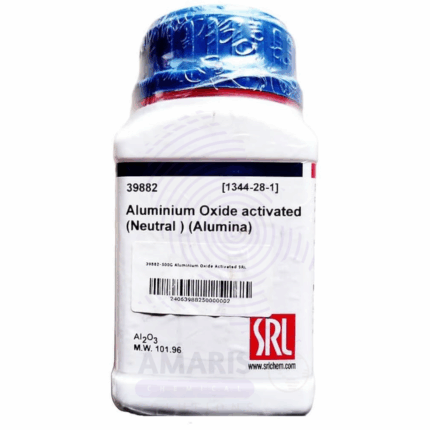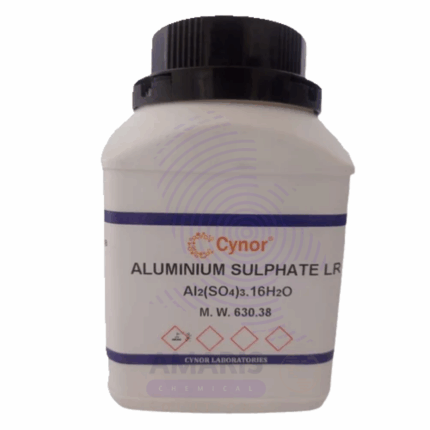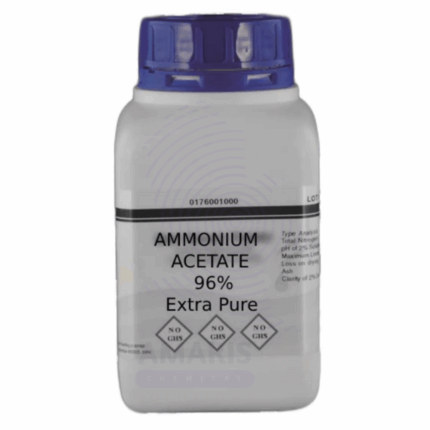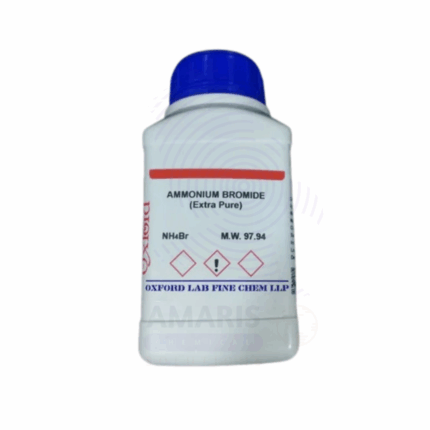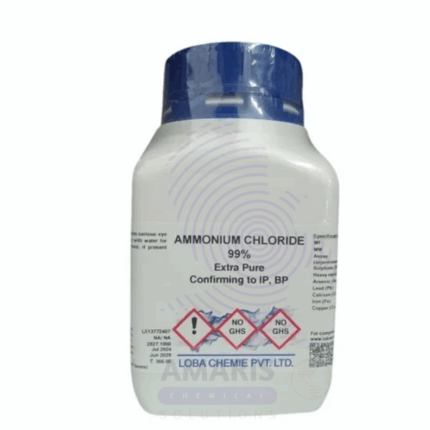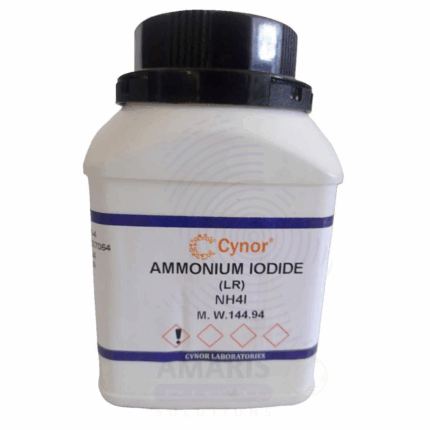
Urea Extra Pure
$ 18.00 Original price was: $ 18.00.$ 17.89Current price is: $ 17.89.
Urea Extra Pure is a high-quality, white crystalline compound widely used in laboratory, pharmaceutical, and cosmetic applications for its high nitrogen content and excellent solubility. It functions as a chaotropic agent in protein studies, a nitrogen source in biochemical and agricultural research, and a moisturizing and keratolytic agent in skin-care products. Its purity and stability make it an essential reagent in analytical chemistry and organic synthesis. Proper storage in airtight containers is necessary to avoid moisture absorption, and handling precautions should be observed to prevent dust inhalation and skin or eye contact.
Urea extra pure Extra Pure
PRIMARY USES
Analytical Reagent & Laboratory Applications:
- Used as a nitrogen source in biochemical assays and protein denaturation studies
- Acts as a chaotropic agent to disrupt hydrogen bonding in proteins and nucleic acids
- Employed in molecular biology for gel electrophoresis and protein unfolding experiments
- Utilized in preparing buffer solutions and reagent formulations requiring high purity urea
Pharmaceutical & Cosmetic Industry:
- Used in topical formulations as a keratolytic and moisturizing agent in creams and lotions
- Functions as a skin conditioner in dermatological products for dry or rough skin
- Applied in the manufacture of urea-based pharmaceuticals and controlled-release fertilizers
SECONDARY USES
Agricultural & Research Applications:
- Reference standard for nitrogen content analysis in soil and fertilizer research
- Used in plant tissue culture media as a nitrogen source
- Employed in the synthesis of various nitrogen-containing compounds in lab-scale organic chemistry
Industrial & Laboratory Uses:
- Used in urea-formaldehyde resin production for adhesives and coatings research
- Acts as a stabilizer and raw material in various fine chemical syntheses
- Basic Identification Attributes
Chemical Name: Urea
CAS Number: 57-13-6
HS Code: 3102.10.00
Molecular Formula: CH₄N₂O
Synonyms:
- Carbamide
- Carbonyl diamide
- Physical & Chemical Properties
Physical State: Solid (crystalline or powder)
Color & Odor: White, odorless
Melting Point: 132.7 °C (decomposes)
Boiling Point: Sublimes; decomposes before boiling
Density/Specific Gravity: ~1.32 g/cm³
Solubility:
- Highly soluble in water (~108 g/100 mL at 20 °C)
- Slightly soluble in ethanol
pH Level: Neutral to slightly acidic in aqueous solutions
Vapor Pressure: Low (non-volatile)
Flash Point: Not applicable (non-flammable)
Autoignition Temperature: Not applicable
Viscosity: Not applicable
- Safety & Hazard Attributes
Hazard Class (GHS Classification):
- Generally low hazard; may cause mild skin and eye irritation
NFPA Ratings: - Health: 1
- Flammability: 0
- Reactivity: 0
Exposure Limits: - No specific OSHA PEL or ACGIH TLV; recommended to avoid dust inhalation
Reactivity: - Stable under normal conditions
- Reacts with strong oxidizers
- Storage & Handling Attributes
Storage Conditions:
- Store in a cool, dry, well-ventilated area
- Keep container tightly closed to avoid moisture absorption
Incompatible Materials: - Strong oxidizers
- Acids and bases (can cause decomposition)
Container Type: - Plastic, glass, or sealed metal containers
Shelf Life & Expiration Date: - Stable for several years if kept dry
Special Handling Requirements: - Use gloves, dust mask, and eye protection when handling powder
- Avoid inhaling dust
- Regulatory & Compliance Attributes
Regulatory Status:
- Approved for pharmaceutical and analytical use by USP and FCC
- Listed under REACH, OSHA, and EPA inventories
Transportation Restrictions: - Not classified as hazardous
Waste Disposal Method: - Dispose according to local regulations as non-hazardous waste
- Environmental & Health Impact
Ecotoxicity:
- Low toxicity to aquatic organisms
Persistence in Environment: - Biodegradable and readily decomposed by soil microorganisms
Carcinogenicity/Mutagenicity: - Not classified as carcinogenic or mutagenic
Biodegradability: - Biodegradable organic compound
SAFETY PRECAUTIONS
Personal Protective Equipment (PPE):
- Wear chemical-resistant gloves and protective eyewear
- Use dust mask when handling in powder form
- Wear lab coat or protective clothing
Handling:
- Avoid dust generation
- Work in a well-ventilated area
- Wash hands after handling
Storage:
- Keep container tightly closed
- Store away from moisture and incompatible substances
FIRST AID MEASURES
Inhalation:
- Move to fresh air
- Seek medical attention if irritation persists
Skin Contact:
- Wash with soap and water
- Seek medical advice if irritation occurs
Eye Contact:
- Rinse immediately with water for at least 15 minutes
- Seek medical attention if irritation persists
Ingestion:
- Rinse mouth with water
- Seek medical attention if symptoms develop
FIRE FIGHTING MEASURES
Flammability:
- Non-flammable solid
Extinguishing Media: - Use water spray, foam, dry chemical, or CO₂
Hazardous Combustion Products: - May release ammonia and nitrogen oxides when heated to decomposition
Firefighter Protection: - Wear full protective clothing and self-contained breathing apparatus


 Preservatives(food)
Preservatives(food) Flavor Enhancers
Flavor Enhancers Acidulants
Acidulants Sweeteners
Sweeteners Antioxidants
Antioxidants Colorants(food)
Colorants(food) Nutraceutical Ingredients (food)
Nutraceutical Ingredients (food) Nutrient Supplements
Nutrient Supplements Emulsifiers
Emulsifiers
 Collectors
Collectors Dust Suppressants
Dust Suppressants Explosives and Blasting Agents
Explosives and Blasting Agents Flocculants and Coagulants
Flocculants and Coagulants Frothers
Frothers Leaching Agents
Leaching Agents pH Modifiers
pH Modifiers Precious Metal Extraction Agents
Precious Metal Extraction Agents
 Antioxidants(plastic)
Antioxidants(plastic) Colorants (Pigments, Dyes)
Colorants (Pigments, Dyes) Fillers and Reinforcements
Fillers and Reinforcements Flame Retardants
Flame Retardants Monomers
Monomers Plasticizers
Plasticizers Polymerization Initiators
Polymerization Initiators Stabilizers (UV, Heat)
Stabilizers (UV, Heat)
 Antifoaming Agents
Antifoaming Agents Chelating Agents
Chelating Agents Coagulants and Flocculants
Coagulants and Flocculants Corrosion Inhibitors
Corrosion Inhibitors Disinfectants and Biocides
Disinfectants and Biocides Oxidizing Agents
Oxidizing Agents pH Adjusters
pH Adjusters Scale Inhibitors( water)
Scale Inhibitors( water)
 Antioxidants(cosmetic)
Antioxidants(cosmetic) Emollients
Emollients Fragrances and Essential Oils
Fragrances and Essential Oils Humectants
Humectants Preservatives
Preservatives Surfactants(cosmetic)
Surfactants(cosmetic) Thickeners
Thickeners UV Filters
UV Filters
 Fertilizers
Fertilizers Soil Conditioners
Soil Conditioners Plant Growth Regulators
Plant Growth Regulators Animal Feed Additives
Animal Feed Additives Biostimulants
Biostimulants Pesticides (Herbicides, Insecticides, Fungicides)
Pesticides (Herbicides, Insecticides, Fungicides)
 Active Pharmaceutical Ingredients (APIs)
Active Pharmaceutical Ingredients (APIs) Excipients
Excipients Solvents(pharmaceutical)
Solvents(pharmaceutical) Antibiotics
Antibiotics Antiseptics and Disinfectants
Antiseptics and Disinfectants Vaccine Adjuvants
Vaccine Adjuvants Nutraceutical Ingredients (pharmaceutical)
Nutraceutical Ingredients (pharmaceutical) Analgesics & Antipyretics
Analgesics & Antipyretics
 Analytical Reagents
Analytical Reagents Solvents(lab)
Solvents(lab) Chromatography Chemicals
Chromatography Chemicals Spectroscopy Reagents
Spectroscopy Reagents microbiology-and-cell-culture-reagents
microbiology-and-cell-culture-reagents Molecular Biology Reagents
Molecular Biology Reagents Biochemical Reagents
Biochemical Reagents Inorganic and Organic Standards
Inorganic and Organic Standards Laboratory Safety Chemicals
Laboratory Safety Chemicals Specialty Laboratory Chemicals(Special Laboratory Equipment)
Specialty Laboratory Chemicals(Special Laboratory Equipment)
 Demulsifiers
Demulsifiers Hydraulic Fracturing Fluids
Hydraulic Fracturing Fluids Scale Inhibitors(oil)
Scale Inhibitors(oil) Surfactants(oil)
Surfactants(oil) Drilling Fluids
Drilling Fluids
 Dyes and Pigments
Dyes and Pigments Bleaching Agents
Bleaching Agents Softening Agents
Softening Agents Finishing Agents
Finishing Agents Antistatic Agents
Antistatic Agents
 Admixtures
Admixtures Waterproofing Agents
Waterproofing Agents Sealants and Adhesives
Sealants and Adhesives Curing Compounds
Curing Compounds Concrete Repair Chemicals
Concrete Repair Chemicals Anti-Corrosion Coatings
Anti-Corrosion Coatings
 Surfactants(cleaning)
Surfactants(cleaning) Builders
Builders Enzymes
Enzymes Solvents (Cleaning)
Solvents (Cleaning) Fragrances
Fragrances
 Electronic Chemicals
Electronic Chemicals Catalysts
Catalysts Lubricants
Lubricants Photographic Chemicals
Photographic Chemicals Refrigerants
Refrigerants Automotive chemicals
Automotive chemicals Pyrotechnic Chemicals
Pyrotechnic Chemicals
 Biodegradable Surfactants
Biodegradable Surfactants Bio-based Solvents
Bio-based Solvents Renewable Polymers
Renewable Polymers Carbon Capture Chemicals
Carbon Capture Chemicals Wastewater Treatment Chemicals
Wastewater Treatment Chemicals
 Pigments
Pigments Solvents(paint)
Solvents(paint) Specialty Coatings
Specialty Coatings Binders/Resins
Binders/Resins Additives
Additives Driers
Driers Anti-Corrosion Agents
Anti-Corrosion Agents Functional Coatings
Functional Coatings Application-Specific Coatings
Application-Specific Coatings
 Fresh Herbs
Fresh Herbs Ground Spices
Ground Spices Whole Spices
Whole Spices Spice Blends
Spice Blends Dried Herbs
Dried Herbs
 Leavening Agents
Leavening Agents Dough Conditioners
Dough Conditioners Flour Treatments
Flour Treatments Fat Replacers
Fat Replacers Decoratives
Decoratives Preservatives(baking)
Preservatives(baking)
 Plasticizers & Softeners
Plasticizers & Softeners Reinforcing Agents
Reinforcing Agents Adhesion Promoters
Adhesion Promoters Vulcanizing Agents
Vulcanizing Agents Antidegradants
Antidegradants Blowing Agents
Blowing Agents Fillers & Extenders
Fillers & Extenders Accelerators & Retarders
Accelerators & Retarders


